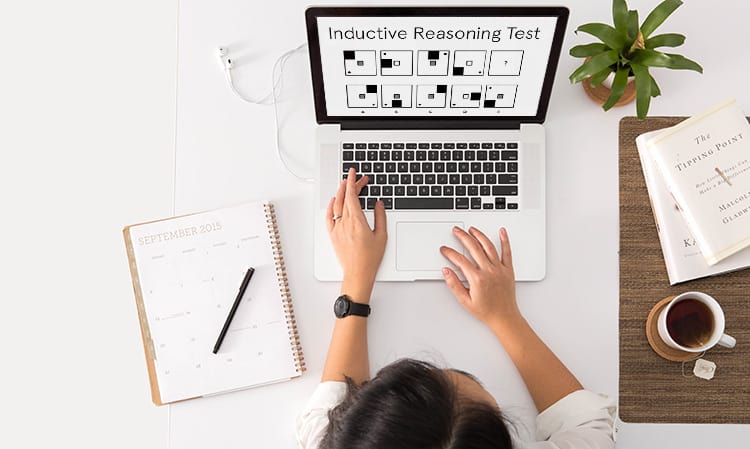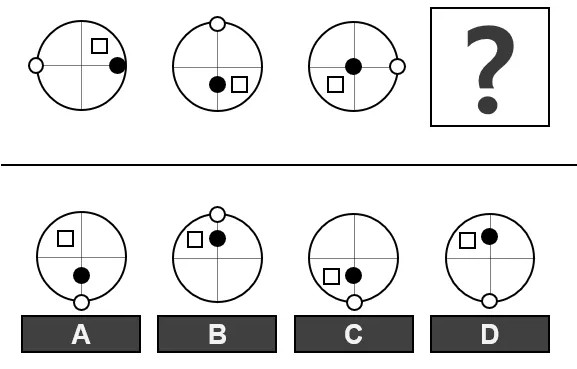Inductive Reasoning Test Guide 2023
Preparing for an inductive reasoning test? These are common in the job selection process, and while they are quite challenging, they’re ultimately nothing to fear. Keep reading for preparation advice, tips and solving strategies to help you pass your inductive reasoning test.
In this free inductive reasoning test guide we will show you:
- 3 must-know facts about inductive reasoning tests
- 5 simple tips to help you excel
- Key practice questions with answers
You can find our recommended inductive reasoning practice tests here.
What is an inductive reasoning test?
These psychometric tests measure your ability to recognise patterns, think logically, and work with unfamiliar information.
In other words: They measure your abstract reasoning skills.
In fact, inductive reasoning tests are sometimes also known as abstract reasoning tests, depending on the test provider being used. (You can check out our detailed guide to abstract reasoning tests here!)
So what exactly is abstract or inductive reasoning?
It’s all about how you process information, solve problems, and draw logical conclusions.
If you perform well on an inductive reasoning test, it usually means you can think conceptually, creatively, and can adapt to new rules and situations.
Why employers use inductive reasoning tests in job selection
Inductive reasoning tests are a popular recruitment tool because they give employers an objective understanding of a candidate’s general intelligence and potential.
They show employers how you approach complex, unfamiliar information and problem solving.
Because of that, these tests are particularly useful for finding candidates for roles that require you to accurately analyse a lot of data, such as IT, engineering and finance roles.
Plus, another benefit of inductive reasoning tests is that they’re non-verbal in nature — they rely on symbols and figures rather than words and numbers. That means they don’t require you to understand the language, which makes them ideal for international candidates (or if English simply isn’t your strong suit).
What to expect in an inductive reasoning test
Inductive reasoning tests are multiple choice and strictly timed.
The exact time you have will depend on the number of questions in the test, but you can usually expect to have around 25-30 seconds per question.
The questions will give you a series of shapes or symbols and ask you to either identify what comes next in the series, or identify the odd one out in the series.
This might sound relatively simple, but don’t be fooled. It’s not so simple in practice — especially when you’re working against the clock.
Let’s take a look at some examples of inductive reasoning test questions next.
Inductive reasoning test example questions and answers
The following inductive reasoning test examples from iPrep will show you what to expect with the two main types of questions that can appear.
Question 1: Next in series
Complete the series by identifying what comes next:
ANSWER
How to solve question 1
Here, the shape is rotating 90 degrees clockwise in each step.
The white square and the white circle remain in position, while the black circle moves along the line closer to the white circle with each step.
Question 2: Odd one out
For this question, identify the odd one out in the series:
ANSWER
How to solve question 2
All the shapes in the series are positioned with their base at the bottom, except for E, whose base is at the top.
Inductive reasoning test video tutorial
Here is Part 1 of Assessment Day’s great video tutorial on inductive reasoning tests. So sit back, relax and take some notes!
You can find Part 2 here.
How to pass an inductive reasoning test: 5 pro tips
#1: Practice, practice and practice some more
While inductive reasoning tests are complex, they’re nothing you can’t prepare for. Invest the time to practice for your test — practice does make perfect, after all!
Take real, timed inductive reasoning practice tests to familiarise yourself with the many types of patterns, shapes and symbols you might have to work with.
The more you know, the less likely you’ll come across a question that stumps you.
Plus, preparation also breeds confidence, and confidence is what you really need to ace the test on the day!
#2: Work quickly but carefully
Speed and accuracy are equally important when you sit an inductive reasoning test.
The test is timed, so you’ll obviously need to move through each question as quickly as you can. But do this with care. Many people tend to start skimming and missing vital information when they’re working under time pressure.
Make sure that you also study the questions carefully — and that you fully understand what they’re asking of you — before choosing your answers.
Trust us, you don’t want to let all that preparation go to waste by rushing through the questions and making silly mistakes.
#3: Manage your time
This one goes hand in hand with the tip above. The key to acing any timed test is to manage what time you have.
Use your phone or a stopwatch to time yourself when you take practice tests, and keep practising until you’re comfortable answering questions in 30 seconds or less.
When it comes to the actual test, take a minute before you start to look at how many questions there are in total. Divide the number of questions by the time you have to finish the test — this will tell you more specifically how long you have to answer each question.
Then, just stick to the time and work through at a steady pace. Leave any questions that slow you down and come back to them at the end if you still have time.
#4: Break down each question
Many of the patterns you’ll have to identify in an inductive reasoning test are very subtle. You might not always be able to figure it out right away, and that’s normal. No need to panic.
It can be helpful to break down a pattern by looking at one element at a time. (For example, the location, size, colour or orientation of each shape in the pattern.)
Once you’ve identified each individual element, you’ll be able to see more easily what’s important to the pattern and what’s just extraneous information.
#5: Start at the end
Stuck on a really hard question?
A good strategy for solving complex patterns is to look at it in reverse. Start at the end of the pattern and work your way back.
This gives you a new and different perspective on it, and can often help you spot things you didn’t notice before.
Some more guides to help you succeed…
- Numerical Reasoning: Numerical Reasoning Test Guide: 5 Proven Tips to Succeed
- Verbal Reasoning: Verbal Reasoning Test: What You Need to Know to Pass
- UKCAT: UKCAT Test Guide: 4 Secrets to UKCAT Success 2020
- Watson-Glaser: Watson-Glaser Test: Everything You Need to Know to Pass
- Mechanical Comprehension: Mechanical Comprehension Test Guide 2020





